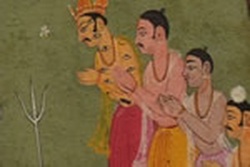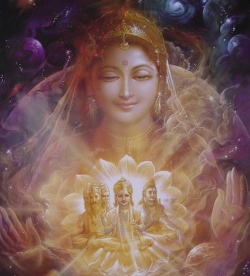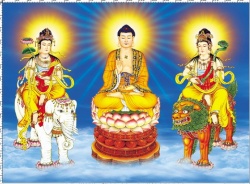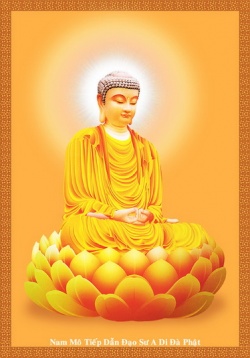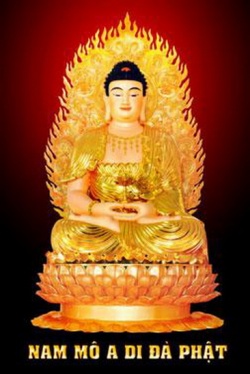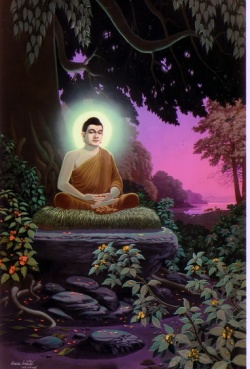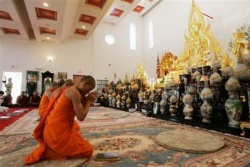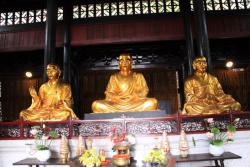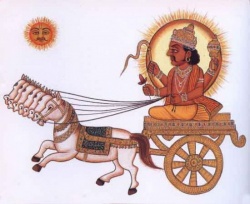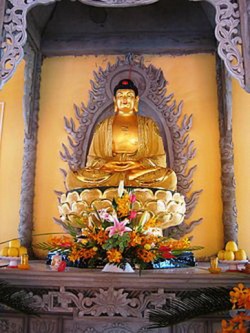The Radical Potential of Shin Buddhism
By Tom Pepper
Recovering Shinran
Why Shinran? Why try to recover this obscure failed Tendai monk from medieval Japan, the founder of what is now the most conservative and least active of Buddhist sects, a Buddhist sect, moreover, that the majority of even long-term Buddhist practitioners in the West have still never heard of? Surely if we want to find the true transmission of Buddhism we should turn to Shinran’s contemporary, Dogen. Or else return to the ancient texts of the Pali Canon to find the true, original Buddhism?
I’m going to make the argument that Shinran’s Buddhism is the most radical approach we could take today to reducing human suffering.
Because so few Western Buddhists are familiar with Jodo Shinshu, I’ll begin with a brief sketch of Shin Buddhism and Shinran’s thought. I will then delineate what I take to be the core universal truth in Shinran’s rereading of Buddhism, the truth his practice is meant to force into appearance for all of us. In the words of Pierre Macherey, “all authentic reading is in its own way violent, or it is nothing but the mildness of paraphrase” (113). Shinran offers an authentic reading of the Pure Land tradition of Buddhism, attempting to recover, to remain faithful to, a truth. I hope to offer an equally authentic reading of Shinran, to remain faithful to that same truth in our very different world. Once I (re)orient Shin Buddhism toward this truth, I will describe the practices Shin demands of us. Shin Buddhism is often called the “path of easy practice,” with the only practice being to say the nembutsu: Namu Amida Butsu. I will argue that it is in many ways the hardest practice of all; furthermore, I will claim that there are really two stages of Shin practice: the practice to attain shinjin, and the practice from within the mind of shinjin. The former is perhaps more difficult, even though the latter requires much more effort.
Shin: a précis [1]
Shinran Shonin was born to a family that was apparently part of the Imperial court at the end of the Heian period. He became a monk at age 9, at the Tendai temple at Mount Hiei. After twenty years, he came to believe that monastic practice was not leading him to awakening, that instead it only produced hypocrisy and power struggles. He left the temple to follow the teaching of Honen, the founder of the Jodo Shu pure land sect. Honen and Shinran wanted to bring Buddhism to the ordinary people, who were almost universally excluded from any participation in the official Buddhism of the time. In the period of the collapse of the Heian Empire and beginning of the Shogunates, their teaching led to some peasant uprisings, and they were both exiled for a time. After the exile was lifted, Shinran continued to teach a form of Pure Land Buddhism somewhat different from Honen’s. While Honen taught saying the nembutsu as the single practice to acquire merit and be born in Amida’s Pure Land at death, Shinran taught that we need not acquire merit, but should say the nembutsu out of gratitude for Amida’s vows.
Amida is the mythical Buddha of eternal life and light. According to the Pure Land Sutras, he was a bodhisattva who eons ago vowed to provide the opportunity for all sentient beings to be born in his Pure Land, where they would instantly become enlightened. Shinran added another twist to this myth, however, emphasizing that nobody remains in Amida’s Pure Land, instead returning as bodhisattvas to work toward producing the conditions for all beings to become awakened. Hence the common Shin saying: the path to the Pure Land is easy, but no one is there.
Shinran emphasized the concept of mappo, the idea that the present age was too decadent for any individual to achieve awakening. We must, instead, rely on “other power” to bring us to liberation from suffering. The goal of Shin practice is the attainment of shinjin, usually translated as “true entrusting,” in which we have confidence that Amida has fulfilled his vows and we will all be born in the Pure Land. Once we achieve shinjin, we will enthusiastically and energetically work to produce the conditions for all beings to become liberated, for all, that is, to attain shinjin.
About two centuries after Shinran’s death, Rennyo Shonin transformed Shin Buddhism, changing the emphasis from attaining shinjin to achieving jinen, a state of “naturalness.” Shin became the dominant religious practice in Japan for centuries, and eventually became a form of emperor worship, a justification for Japanese racism, and an ideological support for Japanese imperialism in the early twentieth century. Given this historical trajectory, one might ask why Shin is worth recovering today. I hope I can give an answer to this question.
Shinran’s Universal Truth
What I find in Shinran that I believe is absolutely worth recovering is his insistence that we are all completely dependently arisen, that we are constructed by our culture and our age, and so in any culture in which some members are excluded from achieving liberation, nobody can achieve liberation. We must all achieve liberation together, as a collective, with no exception, or we will only be achieving an illusory liberation, a distorted image of liberation. The attempt, by any individual, to achieve complete awakening in the midst of a degenerate world cannot succeed, and even the idea of what awakening is will be a false one, defined only by its contrast to the corrupt and oppressive social system it seeks to escape. It will be, that is, only a negative liberation, a negative freedom, the freedom to do nothing at all instead of the freedom to make use of our human potential in the world.
This is what Shinran understood, sitting in the elite monastery of his day, in an age in which the vast majority of the population suffered violent oppression in a state of ignorance. Any awakening that depends upon the ignorance and oppression of others cannot actually be awakening at all, but must only be an illusion, a distorted or perverted image of what liberation might be. In our own time, this takes the form of retreat Buddhism, where the affluent living off the surplus value appropriated from the laboring poor, sit in pleasant and peaceful solitude dreaming of achieving a state of infantile imaginary plenitude, of permanent bliss. This idea of liberation as passive bodily bliss, free of thought or effort or activity in the world, is the twisted image of liberation required in a world were the majority endure alienated labor in poverty and ignorance.
Shinran’s great insight, the universal truth he recovers for Buddhism, is that we must accept that we cannot have any true liberation that depends at all on the oppression of others. We must abandon our attempts at self-perfection, which are anyway only attempts at self-perversion, until we produce a world in which everyone has the conditions to achieve full use of all their potential.
Until this time, we must accept our “blind passions,” we must accept that we are, as Shin Buddhists are fond of saying, “foolish beings.” But this is not a matter of being resigned to our flaws, of accepting passively whatever thoughts or actions may occur, as if they were not really our “true selves,” as the “mindfulness” crowd would put it; instead, we must recognize that these flaws, these “blind passions,” are structurally produced, are the product of the social system we are a part of. The goal is not to suppress these impulses, but to understand their structural causes and work to eliminate those causes, using the very energy of our blind passions to motivate our social activism.
The crucial concept of “other power” in Shin, then, is not some magical god-like power—Amida is a myth, an instructive parable, not a really existing entity. Instead, other power refers to the socially constructed conditions in which we have the opportunity to understand this truth, the truth of the socially produced and collective nature of the human mind. To say Namu Amida Butsu, then, is not to attempt to accumulate magical merit for future bliss, but to express the recognition that the conditions which produced my conventional self are fortunate, because for all the unpleasant “blind passions” I struggle with I also have the capacity to see that they, too, are constructed. I am fortunate to have been produced, dependently arisen, as a subject capable of seeing the causes and conditions of my foolishness, desires, attachments, aversions, and so capable of working to change those causes and conditions, without foolishly attempting to first perfect myself. Such self-perfection is futile, and the “perfect self” would, as I have already argued, be only a distorted reflection of the blind passions I am trying to suppress.
Other power, then, is a term for the causes and conditions that make it possible for us to attain the mind of shinjin. This one term is both the goal and the practice of Shin Buddhism, and so I will try to do my best to explicate it for our contemporary world; to do, that is an “authentic reading” of Shinran.
Shinjin as Goal (Hegel, Plato, Badiou … )
The term shinjin is often translated as “true entrusting” or as “faith.” The common understanding, if any term from Shin can be said to have a “common” understanding at all, is that the goal of Shin Buddhism is to achieve complete faith that we will be born in the Pure Land when we die, in a state of absolute eternal bliss, because of the efforts of a Buddha to whom we should express gratitude. I want to set aside this understanding, completely dismiss it, so that we can begin to understand what shinjin means, how it is the goal and the practice of Shin Buddhism, and how it is the most radical form of Buddhism for us today, one well suited to this age of pending disaster and potential social transformation.
The goal of shinjin is in many ways similar to the goal of Hegel’s phenomenology: it is the goal of achieving a break with the conventional truth, with what Hegel calls “natural consciousness,” the common-sense certainty of our ordinary experience, and of gaining an entry into the philosophical mind. I say “entry into” because it is important that this mind is a collective practice, not a thing we can individually achieve; this is true for Hegel and for Shinran alike: the collective mind of enlightenment (in both the Western and Buddhist senses) is a social practice we must enter into. So I will proceed in a somewhat backwards fashion, first offering what may seem more “accessible” to us, a short account of Hegel’s goal, then explaining its relationship to Shinran’s concept.
In an amazingly lucid and cogent account of Hegel’s thought, Peter Singer explains the goal of this philosophical project. Hegel “never loses sight of the fact that our wants and desires are shaped by the society in which we live…Hence abstract freedom, the freedom to do as we please, is effectively the freedom to be pushed to and fro by the social and historical forces of our time”(38). This purely negative version of freedom can never bring any human happiness; it can at best permit some temporary retreat from suffering if we are able to force an increase of suffering onto someone else. In general, though, it is to mistake absolute determination for freedom; this is the Kantian ambition, to believe we freely choose what we have no choice but to do is the ultimate happiness. Since this perfect correspondence between illusions and necessity rarely obtains, we endlessly struggle and suffer. Hegel’s Phenomenology of Mind is an attempt to lead the reader out of the ordinary “natural” consciousness of existing social formations to an awareness of the social and constructed nature of our “natural” way of thinking. The goal is not, I must point out, the postmodern one of simply asserting that everything is constructed so there’s nothing to do about it; the goal is to see exactly how it is constructed, what effects these constructions have, and decide how we might better construct it. Where the postmodernist simply says “the beautiful is a social convention” and leaves it at that, the Hegelian goal would be to see why this particular convention of beauty exists, and what kind of human thoughts and actions it enables or prevents. The goal is never to suppress our desires so that we can achieve contentment with what we find and call it beautiful; the goal is to recognize the social production of our desires and learn to produce desires we can fulfill actively in the world, not passively in private.
To achieve a real freedom, a positive freedom to work hard in the world and struggle against actual necessity and use our capacities to their full potential, we must first acquire a collective philosophical mind. As Singer puts it, the “greatest obstacle to the rational ordering of the world is simply that individual human beings do not realize that their minds are part of this universal mind”(89): “Hegel believes consciousness to be necessarily social…Individual minds exist together, or they do not exist at all”(95-96). Removing this obstacle to freedom, and beginning to “rationally order” the world we have inherited, cannot be achieved individually, but must be a collective effort. The goal of philosophy becomes to make everyone a philosopher, not so that everyone will then understand the answers to our problems, but so that they will understand the nature of those problems, and can begin to live as free human beings collectively engaged in solving them—a solution, of course, that never ends. The moment we wish for a final solution so that we can stop doing all that difficult thinking, we have abandoned the philosophical mind for the errors of “natural consciousness.” But once we really do achieve this philosophical mind, there is no chance of falling back, no way to “unsee” what we have seen.
This is the goal of the practice of Shin: to bring all individuals into the collective philosophical mind, so that we can begin to make a world in which we can use our full bodily and mental capacities, instead of trying to suppress them or deny them—a world in which we will not have socially produced desires of a kind that need suppression. The mind of shinjin is exactly this collective, philosophical mind: “The mind with which one entrusts oneself to Amida’s Vow is the mind of Amida, and it is precisely with this true and real mind that one is able for the first time to realize one’s own nature as being possessed of blind passions”(CWS II, 46).[2] The mind of Amida incorporates or interpellates us as a new kind of subject, a subject that sees the universal truth of the social constructedness of our collective mind, and our ability to escape the determination of pure animal natural history and live as liberated beings. This is a mind not dependent on cultural truths, but structured by the universal truth of the cultural creation of ordinary consciousness. Any practice that is dependent on specific cultural trappings—language, clothing, sitting postures, etc.—is not a part of this universal subject of Amida, except to the extent that we can reject or change those cultural trappings, do without them completely, even practice Buddhism, for instance, sitting in a chair in jeans and a t-shirt, conducting services in English, and using guitars or pianos instead of bells and gongs. If we cannot do that, we have not yet achieved shinjin.
Shinjin is, as I said, both a goal and a practice. This is because the “mind of Amida” requires our efforts to work in this world to incorporate other individuals into this collective subject of truth: “Shinran…emphasizes the organic unity of realization of the culmination of going forth and as return to this world”(CWS II, 52). It is essential that the individuals who see this truth, become part of this subject, will “become superior bodhisattvas working in this world for the salvation of all beings”(CWS II, 53; emphasis added): “while bodhsattvas who advance through stages are liable, in the seventh stage, to fall into complacency with their own realization and enter a nirvana in quiescence, those born in the Pure Land are never subject to this failing” (CWS II, 54). They are never subject to this failing because they are subjects founded on an absolute truth, not on any particular cultural practice which might provide personal comfort in place of full human living.
Shinran ends the chapter on “realization” in True Teaching, Practice, and Realization, his major work, with a long passage from Vasubandhu, in which the possibility of an absolute knowledge is explained:
True and real wisdom is wisdom that is true-reality. Because true reality is formless, true wisdom is no-knowing. Uncreated dharma-body is the body of dharma-nature… Because it is formless, it never fails to manifest every kind of form…Because it is no-knowing, it never fails to know all things. Therefore, all-knowing wisdom is itself true and real wisdom. (CWS I, 165)
Most readers of this kind of passage would do one of two things: either pass over it as a lot of mystical nonsense to be ignored as the naïve spiritual beliefs of the past, or nod approvingly at the deep wisdom they won’t admit they can make no sense of. What I want to do is to subject it to a strong reading, to draw out the implications of this for Shin Buddhism as a whole. What we must understand is that this is almost identical to the explanation of “absolute knowing” of the philosophical mind that Hegel offers us, and that for both, there is no idealism at all in this account (despite the common reading of both Hegel and Vasubandhu as idealists). Here is a brief explanation, from Terry Pinkard, of Hegel’s concept of philosophical knowledge:
Philosophy is the reflection on what the community as a whole has come to take as authoritative …in terms of an appeal to standards of rationality that themselves have been developed within the history of that community’s accounts of itself. It can therefore legitimate that account only within those historically generated terms, within that “social space,” not by accommodating itself to any kind of object external to the historically developing set of practices of reason-giving and account-giving themselves. Absolute knowledge is absolute in that it has no “object” external to itself that mediates it in the way the natural world mediates the claims of natural science. Absolute knowledge is thus the way in which absolute spirit articulates itself in modern life; it is the practice through which the modern community thinks about itself without attempting to posit any metaphysical “other” or set of “natural restraints” that would underwrite those practices. (262)
The lack of object of this kind of knowledge, its lack of an external referent, is exactly the same as the “no-knowing” of true wisdom for Vasubandhu. This kind of knowledge is completely immanent, a knowledge of or about the ordinary understanding with which we engage the world. We, as a collective subject, as a mind existing in discourses, can “know all things” because we know that our ordinary knowledge is a system of “standards of rationality,” and can examine them from within, from the points of limitation and contradiction. This is the wisdom of the true mind of shinjin, which is completely immanent, not dependent on any metaphysical other, but an immanent knowledge of the constructedness of our ordinary knowledge, and of the social practices that construction enables as well as those it prevents.
We achieve this knowledge, this wisdom, in a particular social practice—for Hegel, the practice of philosophy, for Shinran, the practice of Shin Buddhism. Let me offer one more example, one more version of this achievement of shinjin, before moving on to a discussion of the practice which shinjin is in our everyday life. Because true shinjin is something that, once achieved, can never be lost but it is not a static state—it is not on the order of a “fact” we keep in our memories. Instead, it is more like a way of knowing, that we go on doing every day in our every interaction with the world. The focus, for Shinran, on not going to, but returning from, the pure land is essential here—because shinjin is the endless effort with every word and action to continue to incorporate more individuals into the collective subject of Amida’s mind. If this makes shinjin sound a bit like some kind of assimilation by the Borg or “Invasion of the Body Snatchers,” well, it is—and we need not be terrified of this. It is the elimination of our error that we are “free” when we are in fact completely determined, “pushed to and fro by historical forces” like leaves in the wind. And it is the acceptance of the need to make real mental and bodily effort to escape being mere automatons, mere effects of a structure, and acquire real agency. Or, to put it more precisely, in order to effect real change, the collective subject must put its individuals to work, make use of them, with full awareness of the collective nature of this action, with no illusions of individual minds: bodies must be used to produce a change, instead of running on in the same mechanistic loop reproducing the same social formation under the repetitive work song or cadence call of “freedom, choice, self-determination.”
And in the history of Western philosophy, what example of this attempt to introduce individuals to the truth, to free them from their chains against their will, is better known than Plato’s allegory of the cave? I want to consider, here, Badiou’s “hypertranslation” of this story, in which he describes the “orientation toward the truth” in terms that I think are perfectly compatible with my understanding of the concept of shinjin. Consider the situation of, in Badiou’s version, the spectators in a theater, chained to their seats:
In the cave of illusions, who has the starring role? Who could pride himself on having it over all the others? Who but someone whose sharp eye and sense memory took note of the passing shadows, recognizing the ones that came back often, the ones that were rarely seen, the ones that came in groups or always came by themselves. Someone, in short, who was the best able to guess what was going to occur next on the constraining surface of the visible. (215)
This is our everyday knowledge, our “natural consciousness,” and it is not, exactly, wrong—rather, it is limited. It accepts as a matter of probability or pure chance the failures of prediction, the inability to guess what will happen next among the shadow puppets it sees, which are really there, not hallucinations or illusions. What this consciousness doesn’t know is its own limits—it has not yet even considered that there are any unknown causes. To turn around, to see the puppets themselves and the lights behind them, is still not to know all the causes of what is occurring, but it is absolute knowledge, in the Hegelian sense, it is shinjin, because it is to achieve the awareness that there just are causes we don’t yet know, and there are reasons, beyond pure chance, for any inconsistencies or failures in prediction about the shadows on the screen. We know, finally, that they are shadows, real shadows, really existing, but the shadows of something other than themselves. Absolute knowledge is always knowledge of the limits of our conventional knowledge. In Shinran’s terms, no-knowing is all-knowing: true wisdom is not a content in our mind, but the understanding of the collective construction of that mind, and the limits of our existing state of knowledge. Instead of allowing this great insight to be transformed into anti-intellectual mysticism, we should try to recover it as a daily practice to eliminate suffering and produce joy in the world.
One important consideration here is that this is a practice for everyone. Although it might seem that this is an exclusionary practice, limited to those with the greatest natural intellectual capacities, we must understand that that is not the case. Because all of us can be more habitually aware of the limits of our knowledge, whatever that knowledge is. As Socrates says in Badiou’s translation of Plato’s Republic: “education isn’t a matter of imposing, but rather of orienting”(218). Whether the knowledge we are dealing with is knowledge of particle physics or of our common-sense understanding of “human nature,” what is essential is that we be “oriented” toward awareness of the constructedness and limits of this knowledge. And this is something that must be done by everyone: “Let’s call ‘philosopher’s’ everyone—and in the long run that can be, that must be, anyone—whose natural inclination is to be oriented by an idea…forcing our philosophers to be concerned about those who aren’t ones yet…to support them in the reorientation of their lives”(221). The question we must pose for ourselves, then, is the one that Badiou has Glaucon ask Socrates: “What sorts of exercises or techniques can effect a reorientation like that?”(218).
The Practice of Shinjin
The mind of shinjin is the orientation toward the truth, and the truth is understood to be the awareness of the constructed and intentional nature of all of our beliefs and practices. We may have a more or less correct understanding of the mind independent reality, but the reason we develop that understanding is never free of ideology in the positive sense—that is, of ideology as the beliefs in practices which enable us to reproduce our collective knowledge, to increase our productive capacity, and to reduce human suffering and allow us to escape the blind determinations of natural history. If I plant a fruit orchard, it is clear enough that this depends on correct knowledge of how plants grow, on what kind of fruits are edible, etc. But it is often less clear to us that this is an ideological activity: the social organization which supports division of labor, ownership of land, the increase of efficiency in food production in order to maximize leisure time, settled and permanent habitation, etc., all of this depends on ideological values, on beliefs, particular practices in which we conduct our lives, and the shaping of our enjoyments and desires. We are never without these ideologies, and they are never “true” in any universal sense. Any ideology is humanly constructed and can be changed.
The difficulty with ideology is in the inherent tendency to reification. We begin to believe in the naturalness or inevitability of our ideologies, and to become trapped in them. The moment we confuse our ideological practices with mind-independent reality, our ideologies become fundamentally contradictory. The goal of dialectical thought is to remain aware of the meanings of those contradictions, to avoid trying to resolve them and instead to use them to endlessly recall ourselves to the constructedness of our world, of our loka in Buddhist terminology. The practice of shinjin, then, is the endless work of this dialectical thought, the perpetual examination of the contradictions produced by the categories in which we construe the world—but, most importantly, the goal of this dialectical thought must not be the postmodern goal of simply asserting that all beliefs are relative and so all are equally valid. Instead, the goal must be to sort out which concepts are true about the mind-independent world and which are humanly constructed categories and values, and then to pass judgment on these humanly constructed (ideological) values, to determine which are useful and which are oppressive, to refuse the absolute tolerance which demands that we accept any ideological position and refuses to critically evaluate human cultures. When an ideological contradiction is the motivating energy behind constructive and beneficial practices it should be accepted, if perhaps ameliorated; when it is the source of obfuscation, repression, and alienation, it should be eliminated in thought and practice. The goal of dialectical thought, then, is not the Western Buddhist goal of suspending all judgment; rather, the goal is to relentlessly make better judgments. We must be judgmental in all things, at all times. I’ll come back to this point at the end, with some examples that I hope will make it clearer.
First, though, I want to address what I suspect will be the common objection to my explanation of Shin Buddhism. Because as Shin became popular in the West, it became popular exactly as a kind of anti-intellectual postmodern ideology of passive acceptance of everything “just as it is,” and retreated into thought-free comfort of purely emotional and mindless devotion. I expect that it may appear that my interpretation of Shin is simply the wishful projection of a Western leftist. It is the case that most of the discussion of Shin in the West (what little there has been) emphasizes the conservative strand of the practice, in the line following from Rennyo to Japanese imperialism. Just as with all Western Buddhism, for which the tradition of rigorous philosophical thought stretching back thousands of years to the very earliest Buddhism is not “real” Buddhism, and all of the millions of Buddhists before the 1960s were completely mistaken about what Buddhism “really” is, Shin Buddhism in the West is very anti-intellectual, and ignores the thought of Shinran and the Shin tradition in Japan. So I want to offer the thoughts of just a few Japanese Shin Buddhist scholars, to demonstrate that there is an alternative strand of Shin thought which has always been, and remains, powerfully radical and intellectually demanding.
I will begin with Dennis Hirota, a professor of Shin Buddhism at Ryukoku University in Kyoto, and the head translator on for the Jodo Shinsu Hongwanji-Ha translation into English of the Collected Works of Shinran. In Asura’s Harp: Engagement with Language as Buddhist Path, Hirota offers his account of what the practice of Shin Buddhism should look like. As Hirota explains it, “for Shinran, truth might be characterized as a fundamental shift in stance, a transformative event in which the self is dislodged from an absolute standpoint and made aware of its conditionedness”(63). This radical decentering of the self occurs in thought, language, discourse, and practice—it cannot occur in silent introspection, because it depends on the collective nature of subjectivity, on what in Shin terminology is called “Other Power.” The invocation of the name of Amida Buddha, then, is not meant to be a devotional production of merit (Shinran explicitly rejected the emphasis on saying the name to acquire merit, which was the position of his teacher Honen). Instead, the nembutsu becomes a sort of strategy to displace the transcendental signifier, to cut loose the quilting point that anchors the symbolic system:
The words that define our world and shape our interactions with others all harbor in their depths the distortions of self-attachment. To plumb each word, then, is to recover in its depths the Name as the arising to awareness of the horizon of the self. (118)
The meaning of saying Namu Amida Butsu, then, is simply the reminder, the acknowledgement, of the possibility of dialectical thought, a possibility that only exists because of the collective nature of the mind, because of Other Power. The goal of the “Nembutsu Practicer,” then, is less the acceptance of certain metaphysical assertions than the nature of the conceptual constructions of the world…[t]he problem is to come to a coherent and intelligible understanding of oneself and the world that ignores neither the historical and emotional boundedness of the self nor the variety and worth of experience…[that] allows for the growth of awareness, which ceases to be repetition of prior attachments and become genuinely creative activity in the world. (121-122, emphases added)
This approach may not be the dominant form of Shin Buddhism today, but certainly Hiroata’s work demonstrates that it has warrant in Shinran’s writing, and that it is understood as a viable interpretation by Japanese scholars of Zen.
Perhaps the most compelling evidence for the radical potential of Shin in the modern world is the work of Tanabe Hajime. Tanabe was a part of the Kyoto school of Japanese philosophers that combined Zen thought with Western thought in the years leading up to and during World War II. Tanabe studied at the University of Frieburg under Heidegger, and was a supporter of fascism and Japanese imperialism until the war. After the war, he became despondent over his support of the war effort, and abandoned Zen for the study of Shin Buddhism. His work Philosophy as Metanoetics presents the goal of philosophy as perpetual dialectical critique, and argues that while Zen functions to reify our construal of the world, Shin Buddhist practice enables a constant focus on the “outer limit of ‘absolute contradiction’” (87), and “a negative dialectic prompted by a self-contradiction in thought” (208). The practice of Shin, then, is the practice of perpetual immanent critique. This is what Tanabe finds in Shinran:
I would argue that the philosophy of religion expounded in the Kyougyoshinsho shows a depth whose counterpart is difficult to find in the Western world…My real intention is…to reconstruct philosophy itself through metanoesis in a way corresponding to faith in Other-power. In other words, instead of interpreting Shinran’s teaching in a philosophical manner, I have it in mind here to remold philosophy as metanoetics, to start afresh along the way of philosophy by following Shinran’s religious path. This is precisely how we may learn from Shinran in the true sense of the word, and it is only in this sense that I consider him my teacher. (20)
Metanoetics, for Tanabe, is “a philosophy based upon Other-power”(22), one that “results in the concept of absolute critique,” particularly the immanent critique of philosophy itself. There are clear similarities to the “non-philosophy” of Francois Laruelle, here, but also to Hegel’s “Absolute Knowledge” which, as Zizek reminds us, “does not mean ‘knowing everything.’ It rather means—recognizing one’s limitations”(Less Than Nothing, 388). This limitation is not some external point beyond which we cannot progress, but the internal inherent contradiction always arising when we use conceptual categories to grasp the determinate structure of the world and open up new possibilities for action (always, in the process, closing off some other possibilities…). Absolute knowledge is not omniscience in the common sense of the term; rather, it is an awareness of the constructedness of our ideological interactions with the world—and this is the goal, for Tanabe, of Shin Buddhism and metanoetics, a philosophical project that foreshadows deconstruction and the recent return, in Western philosophy, to dialectics.
One final warrant, then, before I conclude with an example of the radical potential of Shinjin as practice. Takamaro Shigaraki, a Shin Buddhist priest and former president of Ryukoku University, presents a similar understanding of shinjin in his essay “Shinjin and Social Praxis in Shinran’s Thought”:
Taking it another step further, it might be said that shinjin is established where one is able to perceive that the structured norms and value systems of this secular world are limited, false, and deluded, and where one is able to reject and “de-absolutize” them. It is upon this basis that shinjin is able to deepen and continue to expand all the more. This is the fundamental nature of shinjin in Shin Buddhism. (196)
The practice of shinjin, for Shigaraki, is a form of the practice of ideological critique, and its goal is not to generate passivity to but to more consciously choose those ideologies, without “absolutizing” them, which will reduce suffering in the world:
This is the logic of social praxis in Shinran’s thought. Even while he rejects and de-absolutizes the system’s norms and values, Shinran advances a truly courageous social practice; it is a praxis of determination, choice, and action. He promotes the performance of actions, which are willfully chosen at the risk of one’s very self within shinjin. (212)
Nonetheless, he is aware that the institution of Shin Buddhism in Japan has mostly sought to contain this radical potential:
The teachings of Shinran clearly point in the direction of a social praxis based in shinjin. However, after Shinran’s death, the basis for such courageous action came to be suppressed within Shin Buddhist doctrinal studies, as well as by its sectarian institutions. In its place was taught a way of life that adhered to and was bound up within the logic of the existing order. (213)
The recovery of the original focus on shinjin, instead of the institutional focus on jinen and political conformity, should be the goal of Shin Buddhists today.
Practicing shinjin today
I will conclude, then, with some brief examples of what it is like to engage in the practice of shinjin, and how it can clarify our thinking, direct our actions, and break our attachments to what Hegel would call “natural consciousness.” At the core of every symbolic system, of every construal of the world, are numerous aporia, gaps, or contradictions, which can indicate our structuring decision, our ideological orientation toward the world. There is no non-ideological orientation toward the world, and so no attempt to produce concepts and categories can be without its internal limits and contradictions. But this need not leave us hopeless and despairing. To borrow a metaphor from Marx, the contradiction between the centrifugal force produced by the Earth’s momentum and the centripetal force produced by the enormous gravity of the sun is resolved only in a practice, the elliptical orbit that keeps both forces alive and active, and produces, as a result, the capacity of our planet to produce and sustain life. Contradictions are inevitable, serving as the structuring gap between the abstract universal and the concrete particular which allows us to make sense of the excessive information of the world and to produce potentialities for action, to escape the sheer determination of our natural history and live as human beings.
The problem is that there is always a tendency to reify a particular set of abstract categories or concepts, to mystify a particular contradiction as the eternal and ineffable limit. And when this occurs, it all too often occurs in the service of an ideology which functions to reduce, rather than increase, our capacity for creative interaction with the world. The practice of shinjin is the practice of producing, propagating and strengthening the collective dialectical mind.
One way to do this is quite simply to address those problems that always seem so impossible to solve, the perennial debates which we cannot ever settle to our satisfaction. This can be done at many levels of abstraction or complexity from the endless debates over euthanasia, abortion and capital punishment, the insoluble mind-body problem. The dialectical mind would recognize that there is no answer to such questions, because they are not the kinds of questions that are meant to have an answer—they are not of the order of question like “how many maple trees are growing in the park?” Instead, they are debates structured around an inherent aporia in our discourse and practices, simultaneously naming and masking the structuring contradictions that keep our practices moving forward. The dialectical approach would not ask “what is the right answer?” but “should we reframe the question?” And the answer need not always be an easy “yes,” because the very negotiation may still be productive for us, giving purpose and meaning to our lives, enabling and producing activities that we find enjoyable, that fill our lives with activity and meaningful engagement with the world. If the mind-body problem remains insoluble, it is, I would argue, because it assumes an incorrect understanding of the mind as an atomistic and transcendent entity, instead of as a collective practice located in social symbolic systems. But does this mean that all of these debates have been meaningless? No, because the “incorrect” framing of the question turns out to be a way of producing ideologies which have enabled the growth of democracy, increased education, the scientific method, and legal equality. If we choose to reframe the question, we want to first consider what limitations this “wrong” way of framing the debate produces, and how best to reframe it to overcome those limitations.
Another approach to the dialectical practice of shinjin is to consider the function of those floating signifiers or place-holder concepts that have incompatible and contradictory meanings in our symbolic systems. Concepts that can never quite be pinned down, that never have a full agreed upon definition, often serve to produce our ideologies, and keep our symbolic systems operating, to allow successful communication in all those other, not so problematic, concepts. Concepts like ideology, addiction, love, and Literature are the quilting points that insure all our other concepts keep serving their function, exactly by remaining contested concepts themselves. Ideology can be the positive set of belief-in-practices that insure that we don’t have to start from scratch reinventing fire with every generation; but it always seems to call up that negative sense of deception and error, because in a sense it is, it is belief in the “reality” of a thing that is only “real” so long as we believe it is—like the laws of a country, or exchange value. Addiction is that great empty term of the whole disciplinary technology of the self theorized by Foucault, naming a behavior that is somehow both a disease and beyond the individual’s control while at the same time being absolutely an individual moral weakness and failure; it serves to perpetuate the reproduction of desire, appetite, consumption as the core values of our social system, and to place the blame for the failure of that system squarely on the individual. Love is the great ideology of the capitalist social formation, both the impossible ideal which we endlessly pursue because its absence must be the source of all unhappiness in our lives, and at the same time it is that fated something which we know full well we cannot get for ourselves because it is a matter of destiny; we must be free to choose who to love, but since there is only one perfect love it can never be a choice at all. This impossible contradiction maintains the balance, the elliptical orbit, of our highly regulated, alienated, state-run economic system with our desire for complete individuality and the illusion of personal freedom; economically, we are completely alienated and at the mercy of an abstract system we can’t see or understand, but individually we are fully free in our love lives.
Finally, then, the realm of the aesthetic. We all want there to be a universal standard of taste, a final decision on what is a good work of art and what is not, what produced just the right balance between form and content, between universal and particular, between thought and sense, effort and enjoyment. The aesthetic is the method of production of all our ideologies, and we know this full well but still want to insist that there is some universal truth in the really “great” works of art. We want a poem to be completely undetermined and open to any and all subjective interpretation, and at the same time to give us an unchanging and universal, so completely objective, timeless truth. Take, for instance, Simon Critchley’s explanation of the poetics of Wallace Stevens:
Stevens’s late poems stubbornly show how the mind cannot seize hold of the ultimate nature of the reality that faces it. Reality retreats before the imagination that shapes and orders it. Poetry is therefore the experience of a failure. As Stevens put it in a famous late poem, the poet gives us ideas about the thing, not the thing itself. (6)
Critchley’s reading reinforces the assumptions of the non-dialectical “natural consciousness,” which we assume is attempting to somehow objectively represent the world. While I think Critchley is correct that this is what Stevens’s poetry is about, that it is about the failure to capture the “thing in itself,” what both fail to understand is that the aesthetic “shaping and ordering” is not a failure, but a productive act. Stevens produces an ideology which reifies a particular construal precisely by this appeal to the ineffable realm of pure experience. As a contrast, consider Zizek’s account of the dialectal aesthetic: “the power of the spirit is precisely to progress from the ‘green’ immediacy of life to its ‘gray’ conceptual structure, and to reproduce in this reduced medium the essential determinations to which our immediate experience blinds us”(397). Far from failing to grasp “the thing in itself,” the work of abstraction allows us greater potential to interact with the external world. The illusion of the great work of art functions as a floating signifier, and empty placeholder, to allow us to generate the socially-produced abstractions we need to produce without calling attention to their constructedness, enabling at least a temporary stability, or collective adherence to conceptual abstractions that we can all work with.
To engage in this kind of dialectical thought, Absolute Knowledge, or immanent critique is the practice of shinjin. It is not, of course, only “critique” in the negative sense. It is also the dialectical decision to adopt a particular core contradiction, knowing full well it is our own construction and not natural or inevitable, because we can see its productive potentials for enabling genuinely creative activity in the world. The Pure Land, on my interpretation of Shin Buddhism, is the social formation in which the collective mind always thinks dialectically. It is the society in which, in the terms of Badiou’s Republic, everyone is a philosopher. And we can only reach this condition collectively. My capacity to think dialectically and act from a self-conscious awareness of my own constructedenss depends completely upon there being other individuals who are incorporated into this collective mind of shinjin. Until we are all part of the dialectical mind of shinjin, we are all still caught in our reifications and attachments and blind passions. The Primal Vow of Amida is nothing more than the recognition that as the collective mind of shinjin incorporates more individuals, our liberation becomes possible.
As individuals, we are foolish beings, trapped in ideologies we mistake for natural truths. To reach the Pure Land, then, would consist simply of being born into a culture that does not reify its ideologies, a collective mind already aware of its constructedness and dependent origination. While Western philosophy has long emphasized the individual achievement of philosophical wisdom, Shin Buddhism recognizes that this is only possible as a collective project. Liberation is collective, and the collective mind is Other Power.
Works Cited
Badiou, Alain. Plato’s Republic. Trans. Susan Spitzer. New York: Columbia University Press, 2012.
Dobbins, James C. Jodo Shinshu: Shin Buddhism in Medieval Japan. Honolulu: Hawai’i University Press, 2002.
Hirota, Dennis. Asura’s Harp: Engagement with Language as Buddhist Path. Heidelberg: Universitätsverlag Winter, 2006.
Macherey, Pierre. Hegel or Spinoza. Trans. Susan M. Ruddick. Minneapolis: University of Minnesota Press, 2011.
Pinkard, Terry. Hegel’s Phenomenology: The Sociality of Reason. Cambridge: Cambridge University Press, 1996.
Shigaraki Takamaro, “Shinjin and Social Practice in Shinran’s Thought.” Trans. David Matsumoto. Pacific World, Third Series Number 11, 2009: 193-217.
Shinran. The Collected Works of Shinran, 2 Vols. Trans. with introductions, glossaries and reading aids by Dennis Hirota, Hisao Inagaki, Michio Tokunago, and Ryushin Uryuzu. Kyoto: Jodo Shinshu Hongwanji-ha, 1997.
Singer, Peter. Hegel: A Very Short Introduction. Oxford: Oxford University Press, 2001.
Tanabe Hajime. Philosophy as Metanoetics. Berkeley: University of California Press, 1986.
Zizek, Slavoj. Less Than Nothing: Hegel and the Shadow of Dialectical Materialism. New York: Verso, 2012.
[1] For a more complete account of the origins of Shin Buddhism, see James C. Dobbins, Jodo Shinshu: Shin Buddhism in Medieval Japan, University of Hawai’i Press, 2002.
[2] CWS refers to The Collected Works of Shinran, translated by Dennis Hirota, Hisao Inagaki, Michio Tokunaga, and Ryushin Uryuzu, Published in 1997 by Jodo Shinshu Hongwanji-ha, Kyoto. Volume I contains translations of Shinran’s writings, and Volume II contains Introductions to the works written by the translators, as well as Glossaries and other reading aids. When the citation is to volume II, it is a citation from one of the introductory essays.
